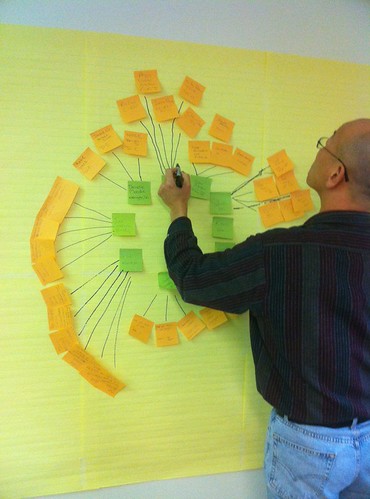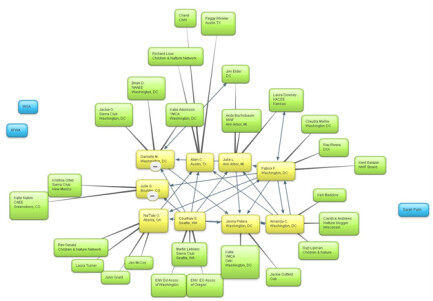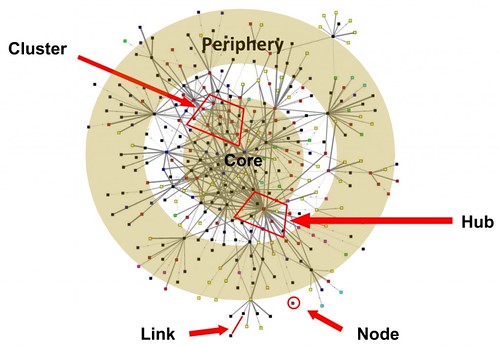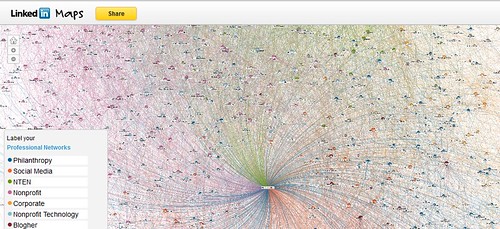
Two weeks ago, the social media maven from the National Wildlife Federation, Danielle Brigida, tweeted the above photo showing how they were mapping one of their networks with one of my favorite low tech tools: sticky notes. This got my attention because I was designing a Networked Nonprofit workshop for E-Mediat and will incorporate a network mapping exercise. Danielle connected me to Daniel Chu, Vice President, Affiliate and Regional Strategies and resident network weaving enthusiast.
Daniel facilitated a network mapping activity with NNF’s 10 education advocacy staff from regional offices and headquarters. They wanted to visualize their network for a specific purpose: getting a national bill (Moving Children Outdoors Act) on Obama’s desk for signature by Oct. 2012.
They used sticky notes to visualize the network. Staff members were at the core of the map. He asked each staff person to add a sticky note with the name of a “go to person” for this issue for their group and location. This became the next “ring” of sticky notes. They discussed any common contacts, and if the two staff shared the same contact were aware of it, and if they have a coordinated “relationship strategy” for that contact ala a triad approach. They also discussed being strategic in the relationship building:
What is the strategic value of investing in the relationship with that person?
Are you the right staff person to have that intensive relationship with that person?
Is there another staff person that makes more sense to bring into the relationship?
The next step was to look for patterns as a group. They reorganized the map into clusters. For example, all clusters associated with formal education or advocacy. This prompted a strategy discussion about how the staff teams might reorganize so that there is a “lead” weaver for each cluster.
Finally, they discussed identifying important potential influentials, either to expand each cluster, or a set of potentials that would actually create a whole new “sector” cluster that is strategically important to build out.
The value? Dan observes, “Overall, the response was positive that such analysis allows the team to be more intentional about weaving a national network for a specific campaign/advocacy outcome.”

Danielle Brigida then use a free online tool called Bubble.us this graphic version of the sticky note map. I’m also thinking that a tool like CrowdMap might be a useful for this exercise as well.
Observations
It is important to have a clear purpose for your network map but use the visualization process to prompt new insights about how you might reach out or connect people in your network to support your goal. Network mapping doesn’t necessarily require complex software. It can be done with low tech tools.
In our book, The Networked Nonprofit, the central thesis is that nonprofits need to work less like isolated institutions and more like networks. To accomplish that, they need to understand networks. Therefore, the first principle in becoming a Networked Nonprofit is understanding networks.
Your network is consists of people and organizations online. You can visualize your professional network or your organization’s network. Both are can be useful in reach your goals. June Holley, the patron saint of network weaving, describes different types of networks as being: relationship networks, support networks, action networks, and formal networks. She says that the mapping can be really valuable for understanding relationship networks by visualizing and seeing patterns and connections.
Networks are more than random gatherings of people and organizations online. Social networks have specific structures and patterns to them. In order to engage them well, NGOS need to understand the fundamental building blocks of their social networks. Shifting focus from organizational to engaging with social networks that exist is the first step. The networks are filled with people who want to help with a cause. NGOs that build social capital and weave their networks can achieve better results.

Before you can carry out this exercise, you need to understand the vocabulary of networks.
Cores: Inner cluster of people who do most of the work on any project or effort.
Nodes: People or organizations
Ties: The connections, communications, reciprocity, similarities, and relationships between them
Hubs: People or organizations that have lots of connections, also called “Influencers”
Clusters: People or organizations that connected to one another, but w/few connections to rest of network
Edge: Vital to growth because these people or organizations are likely to be part of other networks.
Here’s a simple process based on an exercise that Nancy White designed based on the NetMap Process.
1. Assemble a small working group or the “core” that need to work together in a networked way for a particular purpose. State the purpose clearly.
2. Have each person add the “go to” people, organizations, or online communities that help reach their objective. Have them use sticky notes or draw it on a large piece of paper.
3. Have each person identify influencers that they may or not know to help them reach their objective.
4. Identify and discuss specific ties between the core and the nodes – identify overlaps.
5. Look for different patterns or clusters.
6. Share your map with other groups doing the exercise
7. Share your map online.
Some reflection questions to generate insights. You’ll need to revise this so they specifically support your objective.
What people, organizations, or online bloggers/sites are in your ecosystem?
What are the different roles?
Are you connected or not connected?
If connected, how are you connected?
Think about the touch points in your network? How do you appreciate, thank, and celebrate important people in your network?
Think about reciprocity: What have you given people in your network before they have asked?
Update: LinkedIn launched a mapping feature that is useful if you’re thinking about mapping professional networks.

Here’s more about LinkedIn mapping feature.
Beth Kanter is a consultant, author, influencer. virtual trainer & nonprofit innovator in digital transformation & workplace wellbeing.
